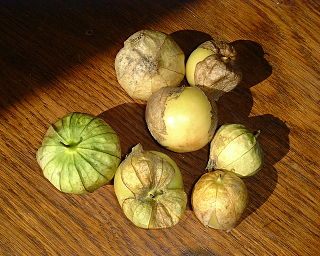
The tomatillo, also known as the Mexican husk tomato, is a plant of the nightshade family bearing small, spherical, and green or green-purple fruit of the same name. Tomatillos originated in Mexico and were cultivated in the pre-Columbian era. A staple of Mexican cuisine, they are eaten raw and cooked in a variety of dishes, particularly salsa verde. The tomatillo is a perennial plant but is generally grown for agriculture each year as if it were an annual.

Amelanchier alnifolia, the saskatoon berry, Pacific serviceberry, western serviceberry, western shadbush, or western juneberry, is a shrub with an edible berry-like fruit, native to North America.

Physalis is a genus of approximately 75 to 90 flowering plants in the nightshade family (Solanaceae), which are native to the Americas and Australasia. At least 46 species are endemic to Mexico. Cultivated and weedy species have been introduced worldwide. A defining feature of Physalis is a large, papery husk derived from the calyx, which partly or fully encloses the fruit. Many species bear edible fruit, and some species are cultivated.
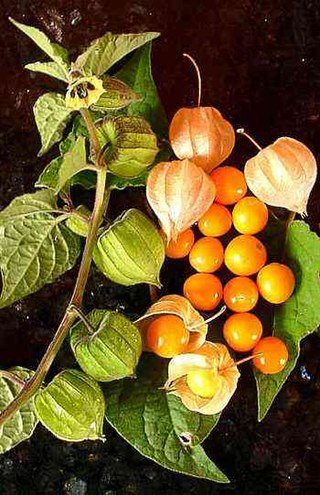
Physalis peruviana is a species of plant in the nightshade family (Solanaceae) native to Chile and Peru. Within that region it is called aguaymanto, uvilla or uchuva, in addition to numerous indigenous and regional names. In English, its common names include Cape gooseberry, goldenberry and Peruvian groundcherry.

Vaccinium parvifolium, the red huckleberry, is a species of Vaccinium native to western North America.

Lonicera involucrata, the bearberry honeysuckle, bracted honeysuckle, twinberry honeysuckle, Californian Honeysuckle, twin-berry, or black twinberry, is a species of honeysuckle native to northern and western North America.

Rubus ursinus is a North American species of blackberry or dewberry, known by the common names California blackberry, California dewberry, Douglas berry, Pacific blackberry, Pacific dewberry and trailing blackberry.

Sambucus racemosa is a species of elderberry known by the common names red elderberry and red-berried elder.
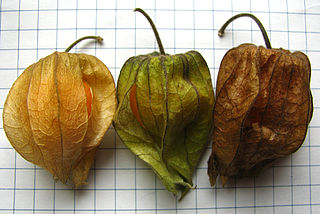
Physalis heterophylla, colloquial name clammy groundcherry, is a herbaceous plant that is a member of the family Solanaceae. It is native to North America, occurring primarily in the eastern United States and Canada. It is known to occur in all contiguous states except for Nevada and California. It is found mainly in habitats such as dry or mesic prairies, gravel hills and rises, sandy or rocky soils, and waste places such as roadsides.

Malus baccata is an Asian species of apple known by the common names Siberian crab apple, Siberian crab, Manchurian crab apple and Chinese crab apple. It is native to many parts of Asia, but is also grown elsewhere as an ornamental tree and for rootstock. It is used for bonsai. It bears plentiful, fragrant, white flowers and edible red to yellow fruit of about 1 cm diameter.

Ribes divaricatum is a species in the genus Ribes found in the forests, woodlands, and coastal scrub of western North America from British Columbia to California. The three accepted varieties have various common names which include the word "gooseberry". Other common names include coast black gooseberry, wild gooseberry, Worcesterberry, or spreading-branched gooseberry.

Physalis acutifolia is a species of flowering plant in the nightshade family known by the common names sharpleaf groundcherry and Wright's ground-cherry. It is native to the southwestern United States from California to Texas, and northern Mexico, where it can be found in many types of habitat, including disturbed areas. It is sometimes a weed when it springs up in agricultural fields, but it is generally not weedy in wild habitat. This is an annual herb producing a branching stem up to a meter tall. The lance-shaped to oval leaves are up to 12 cm long and have edges lined with shallow, smooth teeth. The herbage is coated thinly in hairs appressed flat against the surface. The flowers growing from the leaf axils are round and flat-faced and sometimes over 2 cm wide. They are white to pale yellow with wide, bright yellow centers. The five stamens are each tipped with an anther about 3 mm long. The star-shaped calyx of sepals at the base of the flower enlarges as the fruit develops, becoming an inflated, ribbed lantern-shaped structure about 2 cm long which contains the berry.
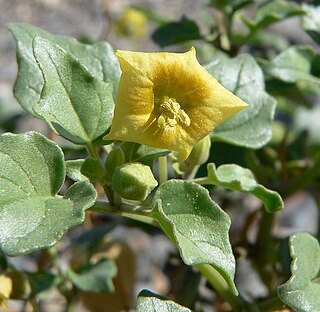
Physalis crassifolia is a species of flowering plant in the nightshade family known by the common names yellow nightshade groundcherry and thick-leaf ground-cherry. It is native to the southwestern United States and northern Mexico, where it can be found in rocky, dry desert and mountain habitat. This is a perennial herb producing a ridged, angular, branching stem approaching 80 cm long, taking a clumped, matted, or erect form. The fleshy oval leaves are 1 to 3 cm long and have smooth, wavy, or bluntly toothed edges. The herbage is glandular and coated in short hairs. The yellow flowers growing from the leaf axils are widely bell-shaped, vaguely five-lobed, and around 2 cm wide. The star-shaped calyx of sepals at the base of the flower enlarges as the fruit develops, becoming an inflated, angled lanternlike structure about 2 cm long, which contains the berry.
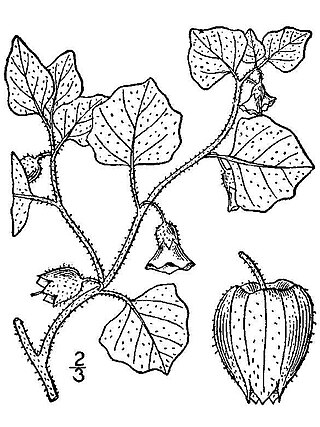
Physalis hederifolia is a species of flowering plant in the nightshade family known by the common name ivyleaf groundcherry. It is native to the southwestern United States and northern Mexico, where it can be found in rocky, dry desert and mountain habitat. This is a rhizomatous perennial herb producing a hairy, branching stem 10 to 80 centimeters long. The gray-green oval leaves are 2 to 4 centimeters long and have smooth or bluntly toothed edges. The flowers growing from the leaf axils are bell-shaped and just over a centimeter long. They are yellow with five brown smudges in the throats. The five-lobed calyx of sepals at the base of the flower enlarges as the fruit develops, becoming an inflated, veined nearly spherical structure 2 or 3 centimeters long which contains the berry.
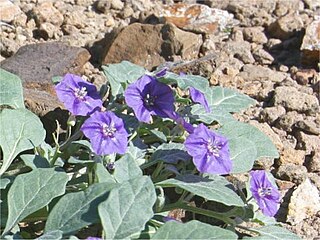
Quincula is a monotypic genus of flowering plants in the nightshade family, Solanaceae. The sole species it contains, Quincula lobata, is commonly known as Chinese lantern, lobed groundcherry, or purple groundcherry.

Physalis pubescens is a species of flowering plant in the nightshade family known by many common names, including husk tomato, low ground-cherry and hairy groundcherry in English, and muyaca and capulí in Spanish. It is native to the Americas, including the southern half of the United States, Mexico, Central and much of South America. It can be found elsewhere as an introduced species and sometimes a weed. It can grow in many types of habitat, including disturbed areas. This is an annual herb producing a glandular, densely hairy stem up to about 60 cm (24 in) in maximum height from a taproot. The oval or heart-shaped leaves are 3–9 cm (1.2–3.5 in) long and have smooth or toothed edges. The flowers blooming from the leaf axils are bell-shaped and about a centimeter long. They are yellow with five dark spots in the throats, and have five stamens tipped with blue anthers. The five-lobed calyx of sepals at the base of the flower enlarges as the fruit develops, becoming an inflated, ribbed, lanternlike structure 2–4 cm (0.79–1.57 in) long which contains the berry.

Physalis viscosa is a species of flowering plant in the nightshade family known by many common names, including starhair groundcherry, stellate ground-cherry and grape groundcherry in English, and arrebenta-cavalo, balãozinho, and camambú in Portuguese and Spanish. It is native to South America, and it is known on other continents as an introduced species and sometimes a weed. It can grow in many types of habitat, including disturbed areas.

Physalis virginiana, the Virginia groundcherry, is a rhizomatous perennial with a deeply buried stem base. It is found mostly in eastern North America as far west as Wyoming.

Physalis pruinosa is a plant in the genus Physalis in the nightshade family Solanaceae, often referred to as ground cherry or husk tomato. It is a native species in a range extending from northern Mexico through Central America. The plant has a low, spreading habit, and fruits develop in a papery husk, as is characteristic of the genus. While most parts of the plant are toxic to humans due to the presence of solanine and solanidine, the fruit becomes edible once it has ripened to yellow. The fruit's flavor is similar in some respects to that of a ripe tomatillo, but notably has a strong flavor of pineapple as well, a fact reflected in the name of a common commercial variety, "Cossack Pineapple". The ripe fruit of Physalis pruinosa var. argentinaJ. M. Toledo & Barboza is a food source for the Pilagá ethnic group.

Alkekengi officinarum, the bladder cherry, Chinese lantern, Japanese-lantern, strawberry groundcherry, or winter cherry, is a species of flowering plant in the nightshade family Solanaceae. It is a close relative of the new world Calliphysalis carpenteri and a somewhat more distant relative to the members of the Physalis genus. This species is native to the regions covering Southern Europe to South Asia and Northeast Asia.




















